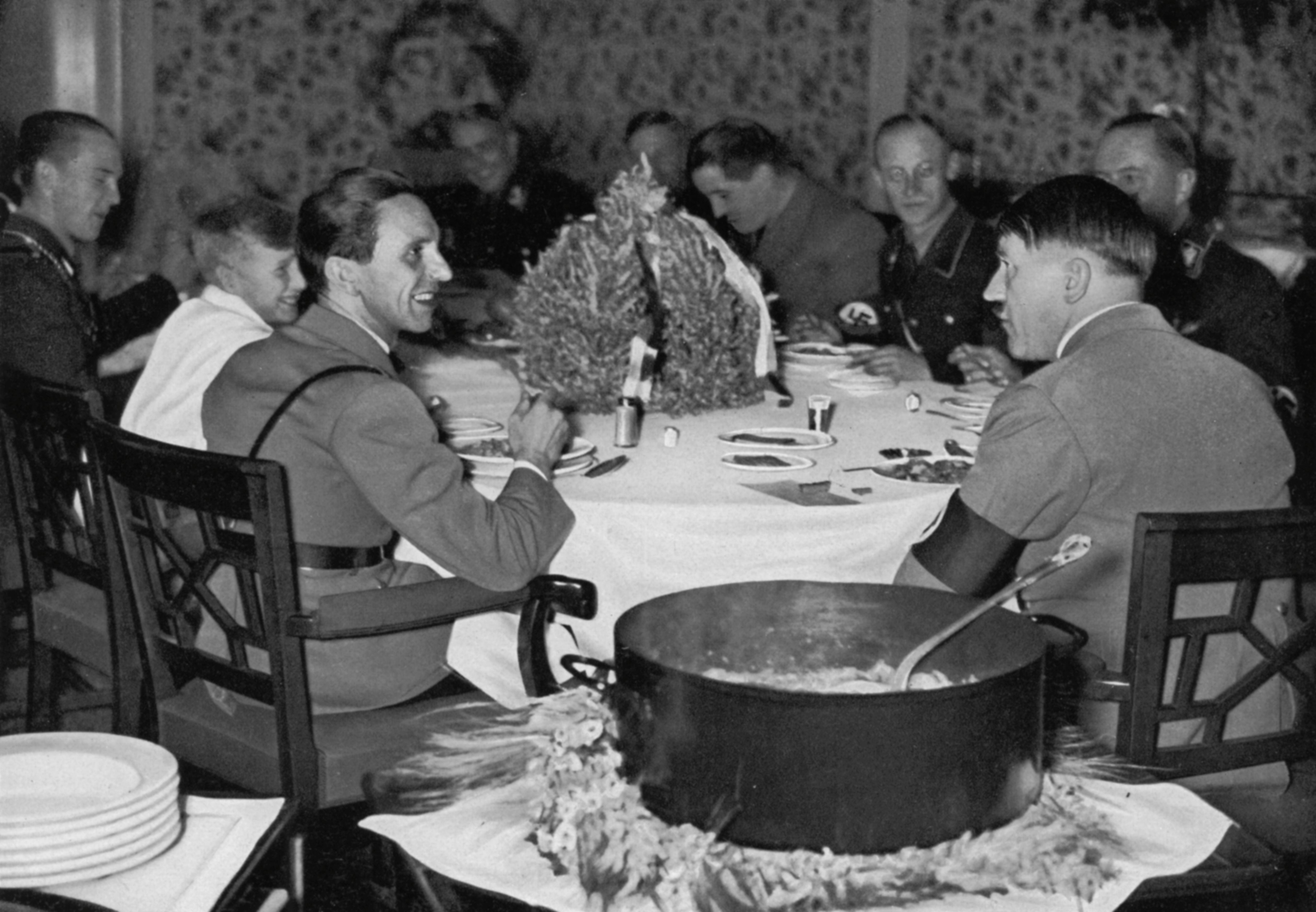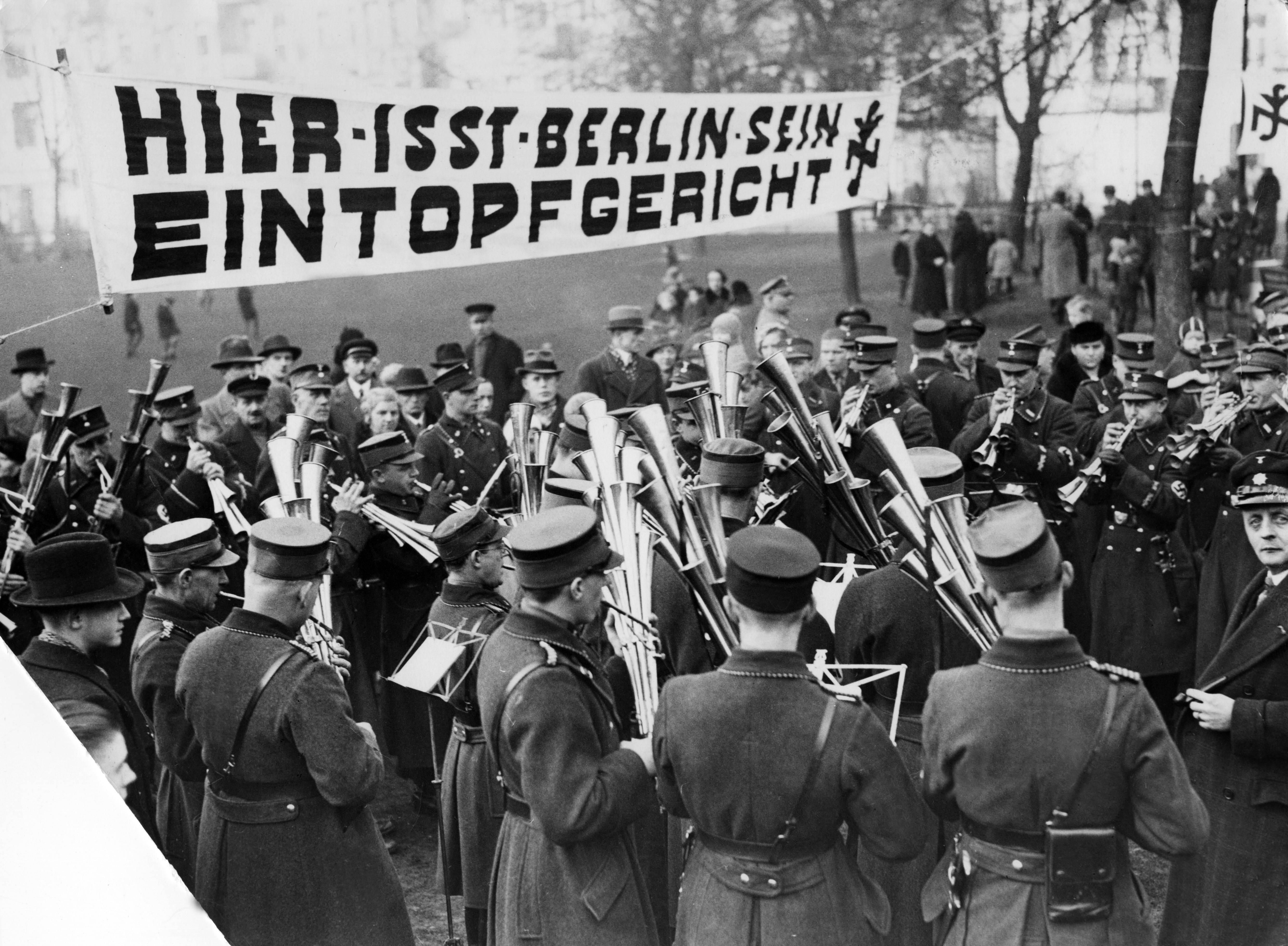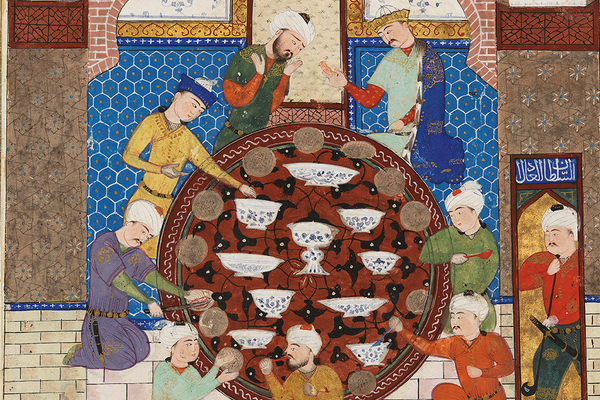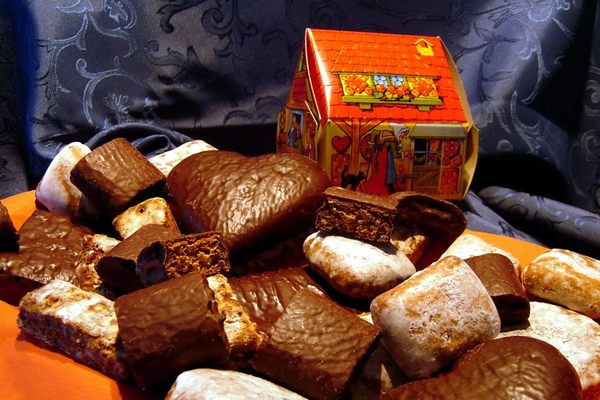The Forgotten Nazi History of ‘One-Pot Meals’
Officials believed the stews and soups had the power to unite Germany.

On October 1, 1933, Germans sat down to an unusually frugal Sunday lunch. For decades, even centuries, the norm had been a roast dinner, usually characterized by a great, bronzed hunk of animal, flanked by potatoes. This was the crowning glory of the week—a meal to be savored and celebrated. But that day, nine months after the Nazis first came to power, Germans ate simple, inexpensive food. Some ate Irish stew; others steaming pots of pea soup, made with Speck and dried beans. Another common dish was macaroni Milanese, a stodgy predecessor to mac and cheese flecked with a confetti of rosy ham. All these dishes had three important things in common: They were inexpensive; they were made in a single pot; and they had been officially sanctioned by the Nazis.
This was the Eintopfsonntag campaign—a Nazi push to make German families eat one-pot meals. Eventually, it would endure well into the Second World War and popularize these stews, soups, and pilafs in Germany for generations to come.
The impetus was an annual charity drive, the Winterhilfswerk, run by the Nazis to feed and clothe veterans and the poor throughout the winter. Wealthier Germans were expected to pitch in as much as they could, but actually getting people to cough up cash had proven challenging. So, in October 1933, the Nazis developed a new campaign centered around these one-pot meals.

On the first Sunday of every month, they decreed, every German family should replace their traditional roast with a thriftier one-pot meal—an Eintopf, from the German ein Topf, or “one pot”—and set aside the savings for the charity drive. On those Sunday afternoons, collectors around the country knocked on doors to recuperate the money. Even families who didn’t want to cook were expected to join in: Restaurants were legally obligated to offer appropriately inexpensive Eintopf meals at a reduced rate on the designated Sundays.
At least initially, Eintopfsonntagen were quite popular. People seem to have enjoyed the challenge of finding meals that fit the bill, and the campaign raised hundreds of thousands of Reichsmarks for charity.
Its popularity was aided by extensive government efforts. As gatekeepers to the German kitchen, housewives and mothers were especially targeted. In time, a whole genre of cookbooks for these kinds of recipes appeared, bolstered by suggestions in magazines and newspapers for one-pot meals. Sauerkraut with lard and broad beans was a classic example—traditional, inexpensive German food that used scraps of meat to canny effect. The government even released children’s books about Eintopf and promotional photos of Adolf Hitler sitting down to a steaming pot of stew. The message was clear: Everyone is doing this, and participation is a national obligation.
In fact, while Hitler officially supported the campaign, he probably did not participate privately. By 1937, he was known internationally as a vegetarian, and had likely been eating a mostly plant-based diet for some time. While Eintopf meals were occasionally meatless, they often featured some bacon or beef. On top of that, Hitler vacillated between preferring a raw diet—he blamed cooked foods for cancer—or extravagant vegetarian meals, occasionally set off with spoonfuls of caviar. Eintopf recipes, on the other hand, were plain, stodgy, and always served hot.
But charity and thrift do not fully explain the Nazis’ zeal for one-pot meals. There was an equally important allegorical element: A single pot meal was democratic and accessible, blurring class lines and undermining bourgeois eating culture. All across the country, Nazi propaganda materials theorized, people of the same race would eat the same diet at the same time: common sacrifice for a common purpose. More than that, writes Alice Weinreb in Modern Hungers: Food and Power in Twentieth-Century Germany, “Cooking in ‘one pot’ (ein Topf) was supposed to symbolize the Nazi creation of ‘one people’ (ein Volk), the crafting of a delicious casserole by combining diverse ingredients analogous to the uniting of the various native German peoples into a single and self-sustaining whole.” (Of course, this so-called diversity—Prussian, Bavarian, Saxon—was as limited and homogenous as many of the suggested dishes.)

To take part in Eintopfsonntag, Germans had to experience deprivation for the good of the collective—a common, unifying Nazi theme. In a 1935 speech, Hitler castigated those who did not take part or give as much as they could to the Wintershilfswerk: “You have never known hunger yourself or you would know what a burden hunger is,” he said. “Whoever does not participate is a characterless parasite of the German people.” Those who greedily refused a day’s abstinence were said to be “stealing” from the collective. As one regional report put it, “Just as faithful Christians unite in the holy sacrament of the Last Supper in service of their lord and master, so too does the National Socialist Germany celebrate this sacrificial meal as a solemn vow to the unshakeable people’s community.”
What went into the country’s pots was equally symbolic. Eintopf recipes favored indigenous ingredients—root vegetables, dried fruit, German pork—and Nazi nutritionists claimed that the best way to nourish the Aryan body was through a racially appropriate diet. In practice, this meant German-grown potatoes and produce. One officially sanctioned cookbook was entitled: “Housewives, Now You Must Use What the Field Gives You! Healthy, Nourishing Meals from Native Soil.”
The aesthetic of Eintopfsonntag similarly drew from a kind of manufactured nationalist nostalgia. Outside of certain northern regions, Eintopf meals had not been popular before the campaign, and the word was unheard of before 1930. Yet publicity campaigns included sentimental images of one-pot meals, eaten in the trenches of the First World War, and rosy-cheeked peasant families tucking into bowls of stew. In the simplicity of an Eintopf meal, Nazis presented a romantic, bourgeois view of some radical, agrarian future.
Over time, however, people grew disillusioned with the campaign. The rich wanted their lavish roasts back, and the poor resented the loss of income. In the underground press, countercultural cartoons criticized the Eintopf obligation. “Which Eintopf dish is the most widespread in Germany?” asked one. The answer: Gedämpfte Zungen. Zungen means “tongues,” and Gedämpfte means both “steamed” and “silenced.” Eventually, amid the chaos of the Second World War, the campaign petered out.
In the end, however, Eintopfsonntagen proved more consequential than the Nazis likely anticipated. More than 80 years later, Eintopf dishes remain popular in modern Germany, and the word is still commonly used—though with scarcely a thought to its strange, racially charged origins.
Gastro Obscura covers the world’s most wondrous food and drink.
Sign up for our regular newsletter.



































Follow us on Twitter to get the latest on the world's hidden wonders.
Like us on Facebook to get the latest on the world's hidden wonders.
Follow us on Twitter Like us on Facebook